外研版(2019) 必修第二册 Unit 5 On the Road Section B Using language 课件-(28张ppt)
文档属性
| 名称 | 外研版(2019) 必修第二册 Unit 5 On the Road Section B Using language 课件-(28张ppt) |  | |
| 格式 | pptx | ||
| 文件大小 | 2.4MB | ||
| 资源类型 | 教案 | ||
| 版本资源 | 外研版(2019) | ||
| 科目 | 英语 | ||
| 更新时间 | 2022-12-05 18:46:31 | ||
图片预览


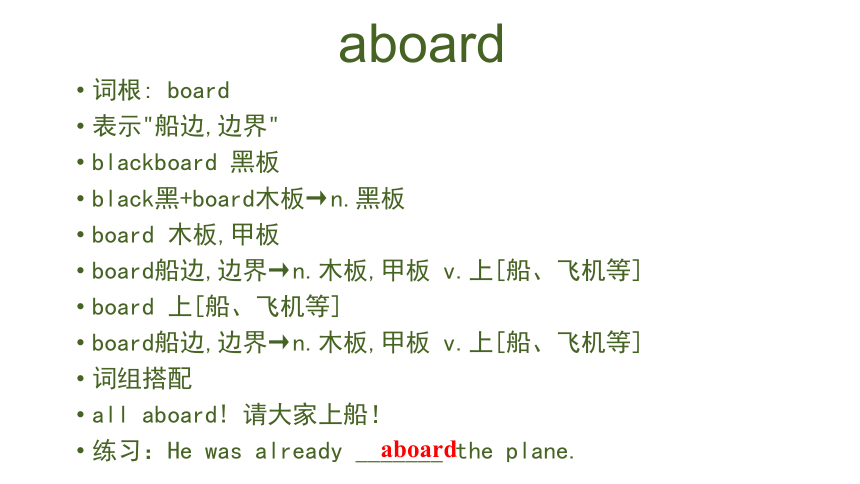
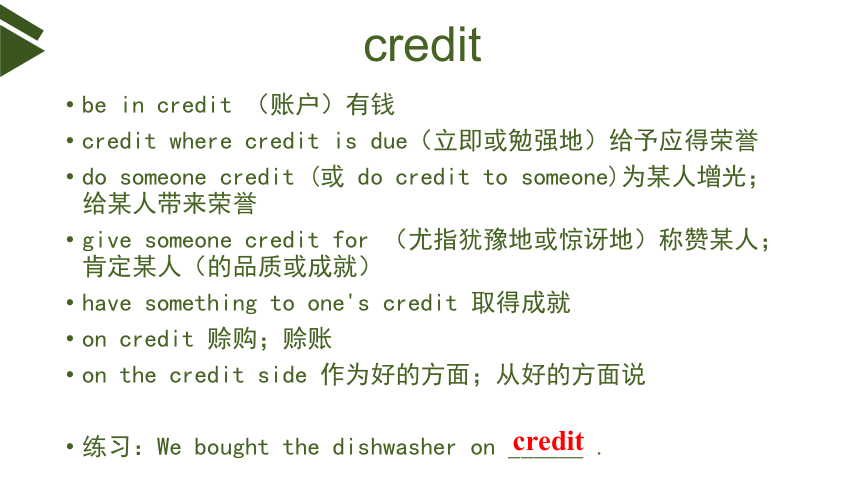
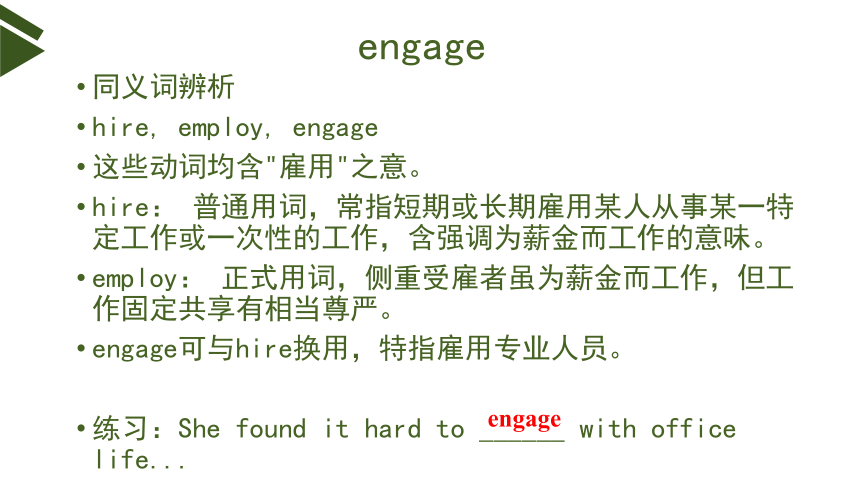

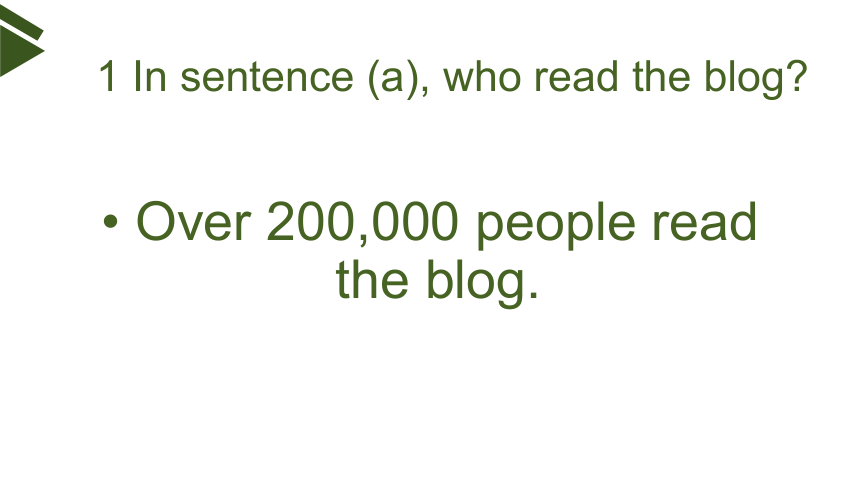
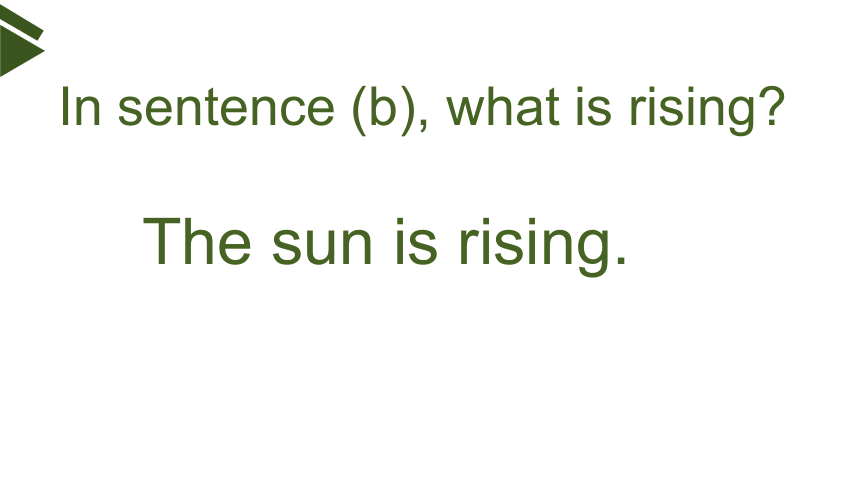
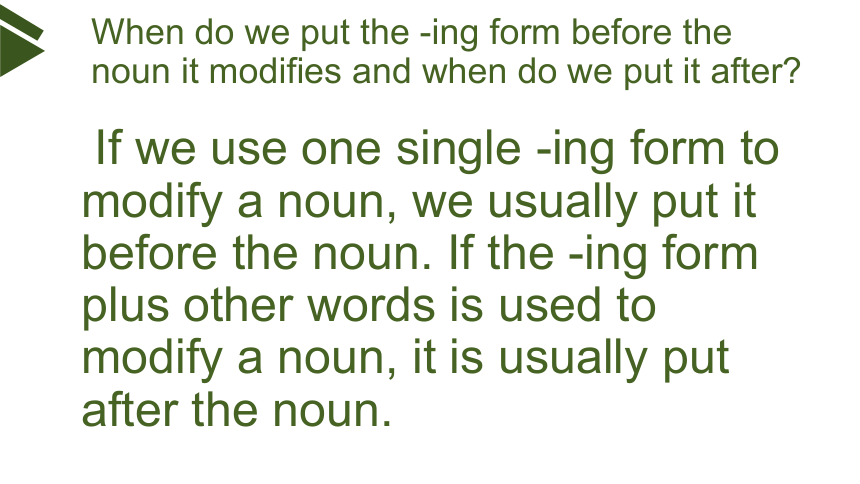
文档简介
(共28张PPT)
On the road
Section B Using language
PRE-CLASS
aboard
词根: board
表示"船边,边界"
blackboard 黑板
black黑+board木板→n.黑板
board 木板,甲板
board船边,边界→n.木板,甲板 v.上[船、飞机等]
board 上[船、飞机等]
board船边,边界→n.木板,甲板 v.上[船、飞机等]
词组搭配
all aboard! 请大家上船!
练习:He was already _______ the plane.
aboard
credit
be in credit (账户)有钱
credit where credit is due(立即或勉强地)给予应得荣誉
do someone credit (或 do credit to someone)为某人增光;给某人带来荣誉
give someone credit for (尤指犹豫地或惊讶地)称赞某人;肯定某人(的品质或成就)
have something to one's credit 取得成就
on credit 赊购;赊账
on the credit side 作为好的方面;从好的方面说
练习:We bought the dishwasher on ______ .
credit
engage
同义词辨析
hire, employ, engage
这些动词均含"雇用"之意。
hire: 普通用词,常指短期或长期雇用某人从事某一特定工作或一次性的工作,含强调为薪金而工作的意味。
employ: 正式用词,侧重受雇者虽为薪金而工作,但工作固定共享有相当尊严。
engage可与hire换用,特指雇用专业人员。
练习:She found it hard to ______ with office life...
engage
a ... there were over 200,000 people reading my blog!
b I love to photograph the rising sun,…
1 In sentence (a), who read the blog
Over 200,000 people read the blog.
In sentence (b), what is rising
The sun is rising.
When do we put the -ing form before the noun it modifies and when do we put it after
If we use one single -ing form to modify a noun, we usually put it before the noun. If the -ing form plus other words is used to modify a noun, it is usually put after the noun.
c ... there were over 200,000 people who read my blog!
d I love to photograph the sun that is rising, …
What is the difference between the two groups of sentences
The first group uses the -ing form as attributive while the second group uses attributive clauses.
Why does the author choose to use sentences (a) and (b)
Because the sentences using the -ing form as attributive are more concise and colloquial.
More sentences in the interview:
Now I spend three weeks out of every month travelling and have over 464, 000 fans following me online.
Today I've been photographing a crocodile swimming close to our boat, the Kimberley Quest, all day.
Over time, this could make her a danger to people living in the area.
WHILE-CLASS
现在分词(短语)作定语
1.位置:单个的现在分词作定语时,通常放在被修饰词之前;现在分词短语作定语时,通常放在被修饰词之后。
Don't wake up the sleeping child.不要吵醒那个正在睡觉的孩子。
The man standing at the window is our teacher.站在窗户旁的那个男人是我们的老师。
2.形式:现在分词(短语)作定语只有doing和being done 两种形式,一般不用having done的形式。
3.意义:doing表示主动、动作正在进行或现在(当时)的状态;being done表示被动且动作正在进行。
We can see the flowers nodding gently in the wind.我们能看见花在风中轻轻摇曳。(表示主动且动作正在进行)A man respecting others will be respected.敬人者,人敬之。
(表示主动和一种状态)
The house being built here belongs to John.这里正在建的那所房子是约翰的。(表示被动且动作正在进行)
4.扩展成句:现在分词短语作后置定语时,可扩展成定语从句。
The man talking with our headmaster is Tom's father. = The man who is talking with our headmaster is Tom's father.正在和我们的校长谈话的那个人是汤姆的父亲。
语法 形式 语态及时间意义
现在分词(短语)作定语 doing 表示主动且动作正在进行或现在(当时)的状态。They lived in a room facing the sea.他们住在一个面朝大海的房间里。
being done 表示被动且动作正在进行。The meeting being held now is of great importance.正在举行的这个会议非常重要。
不定式(短语)作定语 to do 表示主动且动作将要发生。The man to help us is John.将要来帮助我们的人是约翰。
to be done 表示被动且动作将要发生。The medical team to be sent to the flood-stricken areas will set off tomorrow.要派往洪灾地区的医疗队明天就将启程。
语法 形式 语态及时间意义
现在分词(短语)作定语 doing 表示主动且动作正在进行或现在(当时)的状态。They lived in a room facing the sea.他们住在一个面朝大海的房间里。
being done 表示被动且动作正在进行。The meeting being held now is of great importance.正在举行的这个会议非常重要。
不定式(短语)作定语 to do 表示主动且动作将要发生。The man to help us is John.将要来帮助我们的人是约翰。
to be done 表示被动且动作将要发生。The medical team to be sent to the flood-stricken areas will set off tomorrow.要派往洪灾地区的医疗队明天就将启程。
When the -ing as attributive is just a word,it will be placed before the modified word. When the -ing as attributive is a phrase,it will be placed after the modified word.
(1)He is an ___________ player.
(2)He asked an ____________question.
(3)Do you know the number of people_______________.
(4)The boy _______________is my classmate.
attacking
embarrassing
coming to the party
standing by the window
When the -ing as attributive is a phrase, it will be placed after the modified word. And the meaning of it is just like that of attributive clause.
(1)Do you know the number of people_______ = Do you know the number of people_________
(2)The boy ____________is my classmate.= The boy_______________is my
classmate.
coming to the party
who/that came to the party
standing by the window
who/that is standing by the window
AFTER-CLASS
Finish the advertisement on Page 53.
Are you one of those people (1)______(work) around the clock Are you getting "itchy feet" Take a look at our new offer:a once-in-a-lifetime adventure to the beautiful islands of Hawaii!
Go on a boat trip to see whales that jump out of the water and hear the song of dolphins that sing.Watch surfers (2) ______(catch) the waves—and maybe even give it a go yourself!
Put on your (3)______ (hike) boots and explore islands with waterfalls and active volcanoes. And at the end of the day,you won't want to miss the view of the sun
(4)_______ (set) on the sea.
(1)working;(2)catching;(3)hiking;(4)setting
Change the attributive clauses in the following sentences into v-ing.
(1) The man who was driving the car didn't see the old lady who was crossing the street.
____________________________________________________
(2)The man who is talking with my head teacher is my brother.
____________________________________________________(3)The noise woke up the boy who was sleeping.
____________________________________________________
(4) We met a group of pupils who returned from school.
____________________________________________________
Suggested answers:
(1) The man driving the car didn't see the old lady crossing the street.
(2)The man talking with my head teacher is my brother.
(3)The noise woke up the sleeping boy.
(4)We met a group of pupils returning from school.
On the road
Section B Using language
PRE-CLASS
aboard
词根: board
表示"船边,边界"
blackboard 黑板
black黑+board木板→n.黑板
board 木板,甲板
board船边,边界→n.木板,甲板 v.上[船、飞机等]
board 上[船、飞机等]
board船边,边界→n.木板,甲板 v.上[船、飞机等]
词组搭配
all aboard! 请大家上船!
练习:He was already _______ the plane.
aboard
credit
be in credit (账户)有钱
credit where credit is due(立即或勉强地)给予应得荣誉
do someone credit (或 do credit to someone)为某人增光;给某人带来荣誉
give someone credit for (尤指犹豫地或惊讶地)称赞某人;肯定某人(的品质或成就)
have something to one's credit 取得成就
on credit 赊购;赊账
on the credit side 作为好的方面;从好的方面说
练习:We bought the dishwasher on ______ .
credit
engage
同义词辨析
hire, employ, engage
这些动词均含"雇用"之意。
hire: 普通用词,常指短期或长期雇用某人从事某一特定工作或一次性的工作,含强调为薪金而工作的意味。
employ: 正式用词,侧重受雇者虽为薪金而工作,但工作固定共享有相当尊严。
engage可与hire换用,特指雇用专业人员。
练习:She found it hard to ______ with office life...
engage
a ... there were over 200,000 people reading my blog!
b I love to photograph the rising sun,…
1 In sentence (a), who read the blog
Over 200,000 people read the blog.
In sentence (b), what is rising
The sun is rising.
When do we put the -ing form before the noun it modifies and when do we put it after
If we use one single -ing form to modify a noun, we usually put it before the noun. If the -ing form plus other words is used to modify a noun, it is usually put after the noun.
c ... there were over 200,000 people who read my blog!
d I love to photograph the sun that is rising, …
What is the difference between the two groups of sentences
The first group uses the -ing form as attributive while the second group uses attributive clauses.
Why does the author choose to use sentences (a) and (b)
Because the sentences using the -ing form as attributive are more concise and colloquial.
More sentences in the interview:
Now I spend three weeks out of every month travelling and have over 464, 000 fans following me online.
Today I've been photographing a crocodile swimming close to our boat, the Kimberley Quest, all day.
Over time, this could make her a danger to people living in the area.
WHILE-CLASS
现在分词(短语)作定语
1.位置:单个的现在分词作定语时,通常放在被修饰词之前;现在分词短语作定语时,通常放在被修饰词之后。
Don't wake up the sleeping child.不要吵醒那个正在睡觉的孩子。
The man standing at the window is our teacher.站在窗户旁的那个男人是我们的老师。
2.形式:现在分词(短语)作定语只有doing和being done 两种形式,一般不用having done的形式。
3.意义:doing表示主动、动作正在进行或现在(当时)的状态;being done表示被动且动作正在进行。
We can see the flowers nodding gently in the wind.我们能看见花在风中轻轻摇曳。(表示主动且动作正在进行)A man respecting others will be respected.敬人者,人敬之。
(表示主动和一种状态)
The house being built here belongs to John.这里正在建的那所房子是约翰的。(表示被动且动作正在进行)
4.扩展成句:现在分词短语作后置定语时,可扩展成定语从句。
The man talking with our headmaster is Tom's father. = The man who is talking with our headmaster is Tom's father.正在和我们的校长谈话的那个人是汤姆的父亲。
语法 形式 语态及时间意义
现在分词(短语)作定语 doing 表示主动且动作正在进行或现在(当时)的状态。They lived in a room facing the sea.他们住在一个面朝大海的房间里。
being done 表示被动且动作正在进行。The meeting being held now is of great importance.正在举行的这个会议非常重要。
不定式(短语)作定语 to do 表示主动且动作将要发生。The man to help us is John.将要来帮助我们的人是约翰。
to be done 表示被动且动作将要发生。The medical team to be sent to the flood-stricken areas will set off tomorrow.要派往洪灾地区的医疗队明天就将启程。
语法 形式 语态及时间意义
现在分词(短语)作定语 doing 表示主动且动作正在进行或现在(当时)的状态。They lived in a room facing the sea.他们住在一个面朝大海的房间里。
being done 表示被动且动作正在进行。The meeting being held now is of great importance.正在举行的这个会议非常重要。
不定式(短语)作定语 to do 表示主动且动作将要发生。The man to help us is John.将要来帮助我们的人是约翰。
to be done 表示被动且动作将要发生。The medical team to be sent to the flood-stricken areas will set off tomorrow.要派往洪灾地区的医疗队明天就将启程。
When the -ing as attributive is just a word,it will be placed before the modified word. When the -ing as attributive is a phrase,it will be placed after the modified word.
(1)He is an ___________ player.
(2)He asked an ____________question.
(3)Do you know the number of people_______________.
(4)The boy _______________is my classmate.
attacking
embarrassing
coming to the party
standing by the window
When the -ing as attributive is a phrase, it will be placed after the modified word. And the meaning of it is just like that of attributive clause.
(1)Do you know the number of people_______ = Do you know the number of people_________
(2)The boy ____________is my classmate.= The boy_______________is my
classmate.
coming to the party
who/that came to the party
standing by the window
who/that is standing by the window
AFTER-CLASS
Finish the advertisement on Page 53.
Are you one of those people (1)______(work) around the clock Are you getting "itchy feet" Take a look at our new offer:a once-in-a-lifetime adventure to the beautiful islands of Hawaii!
Go on a boat trip to see whales that jump out of the water and hear the song of dolphins that sing.Watch surfers (2) ______(catch) the waves—and maybe even give it a go yourself!
Put on your (3)______ (hike) boots and explore islands with waterfalls and active volcanoes. And at the end of the day,you won't want to miss the view of the sun
(4)_______ (set) on the sea.
(1)working;(2)catching;(3)hiking;(4)setting
Change the attributive clauses in the following sentences into v-ing.
(1) The man who was driving the car didn't see the old lady who was crossing the street.
____________________________________________________
(2)The man who is talking with my head teacher is my brother.
____________________________________________________(3)The noise woke up the boy who was sleeping.
____________________________________________________
(4) We met a group of pupils who returned from school.
____________________________________________________
Suggested answers:
(1) The man driving the car didn't see the old lady crossing the street.
(2)The man talking with my head teacher is my brother.
(3)The noise woke up the sleeping boy.
(4)We met a group of pupils returning from school.
